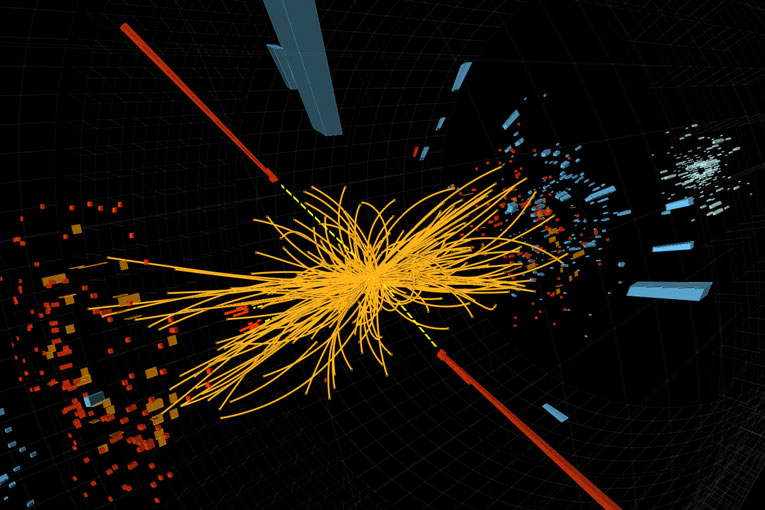
 CERN CERN |
||
|
One of the highest-profile scientists last year was, without a doubt, Peter Higgs. He won the Nobel Prize for Physics, along with François Englert, for anticipating in the sixties the existence of the boson that carries his name, and has appeared on the news all around the world. Theoretical physics has been in vogue for years now. Since CERN announced they were close to be able to confirm the existence of the elusive boson in 2011, physics quickly captured the media attention. Why is such an abstract issue so journalistically relevant? We can find an explanation analysing the discourse of the media on the topic. And that is exactly what Aina Monferrer and Vicent Salvador, researchers at the Jaume I University in Castellón did in an article published on the Journal of Catalan Studies. The authors point to three causes that may have peaked such an interest: the mystery aura surrounding the discovery, the metaphoric fertility that allowed people to picture the phenomenon and the science and religion controversy due to the nickname «God particle». |
«Why is such an abstract issue so journalistically relevant? The authors of the study offer an explanation analysing the discourse of the media on the topic» |
|
|
Puns and metaphors Among the resources used to present the narrative of the boson, the authors identify – within the corpus of analysed texts – four discursive strategies. First, they found in the texts the construction of the hero, the lone genius. Thus, newspapers highlight moments in Higgs’s childhood to inspire empathy in the readers, like his humble origin, his disease or his enquiring nature: «Higgs’s education was unusual. Due to asthma he missed a lot of classes and had to compensate working at home» (El Periódico, 5/7/2012). In the same way, the narrative insists on a journey from the incomprehension of the genius (because his paper developing the idea of the boson was rejected in the first place) to the ultimate recognition (the Nobel Prize, highest honour for a scientist). Another one of the elements hinted by Monferrer and Salvador is the activation of intrigue as an ingredient for the story. In this sense, the search for the boson reminds of the quest for the missing piece in a puzzle, the one making everything fit together. Much as a detective story, where evidence leads the investigators (CERN) to the solution of an enigma set out sixty years before (proving the existence of the particle). Time management plays a key role on intrigue narrative, as different «chapters» keep being unveiled, slowly building towards the solution of the plot. Therefore, researchers emphasise three key dates. The first one, 18 November 2011, when CERN scientists announced they had narrowed down the range of values in which the Higgs boson was expected to be. From then on, the physicist’s presence in the media becomes constant. The second date is a month later, 13 December 2011, when the finding of a particle within the parameters predicted for the mass of the Higgs is announced, although the scientists advice caution because the margin of error is still too high. And the third one is 4 July 2012, when the discovery is validated and the boson acquires ubiquity in the media: «The discovery of the “God particle” opens a new era for physics» (El Periódico, 5/7/12), «Once the Higgs as been “caught”, the time for supersymmetry is upon us» (El Punt Avui, 8/7/12). |
«The search for the boson reminds of the quest for the missing piece in a puzzle, the one making everything in current physics fit together» |
|
|
The third element in the discourse of the media is mystery. The boson appears in the news surrounded by a whole semantic field related to the idea of enigma, of the unknown. «There is also the idea of the boson as a key to open new doors, provoking the old fear to discovery, the fear of knowing», the authors claim. This knowledge, they continue in the paper, can be seen «as the sin of pride and, additionally, it carries the name of God particle». Maybe because of that, the Church issued a press release rejecting the possibility that the finding posed a threat to catholic faith: «It is God’s particle as we all are» (La Razón, 12/7/12). Finally, the study analyses other literaturising tools the media uses: puns («la partícula mal dita», goddam in Catalan – «maldita» – can be separated into «badly named» – «mal dita»), comparisons and analogies («the particles are stopped in a similar way to water slowing a swimmer») and metaphors (to fit the piece of the puzzle or to hunt the boson – as if the particle was an exotic animal). Among these tools, another noteworthy element is plastic imagery. The media need to illustrate the piece of information, but how do they portray the Higgs boson for their public? One of the analysed visual representations shows the explosion that creates the capture of an indication of the boson. According to the researchers, it reminds us of the explosion that originated the universe: «This iconic analogy is not casual. It is rather based on the hypothesis behind the Standard Model of physics: supersymmetry; that is, the fact that the same elements and processes that happen at an elemental particle level have an identical infinitely massive counterpart». Lucía Sapiña. The Two Cultures Observatory. Mètode. University of Valencia. |
||





